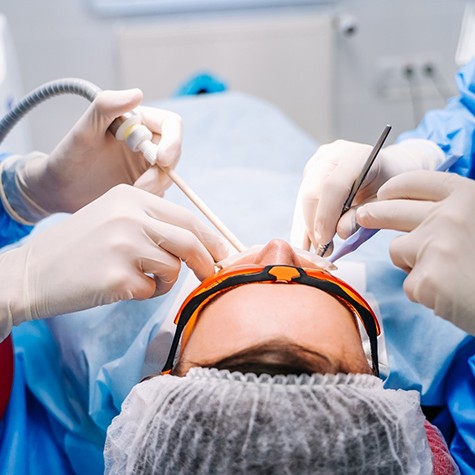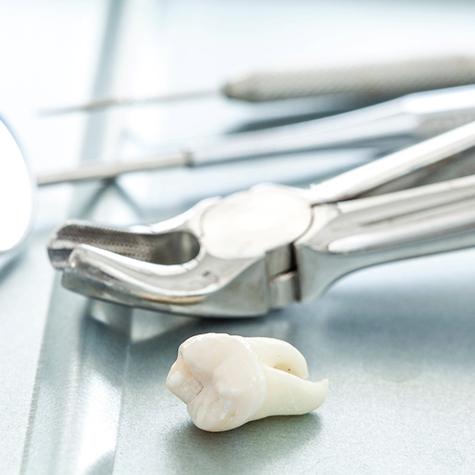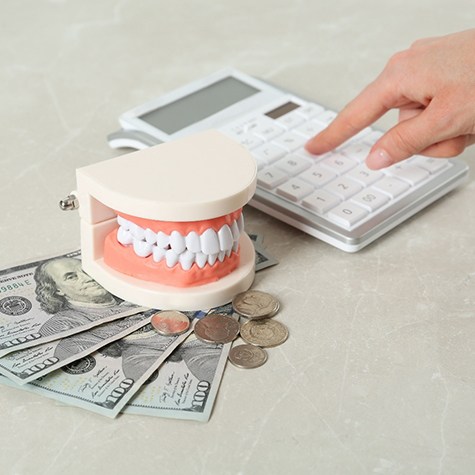SMILES 4U
Doylestown, PA 18901 (215) 345-6500 REQUEST AN APPOINTMENT
When given a choice, Dr. Kandov will always elect to try and save a tooth. Of course, the unfortunate reality is that sometimes there simply isn’t a choice; on occasion, an extraction is necessary to keep the rest of the smile healthy. Here at Olga Kandov, DMD – Brite Smiles, we’ll use the advanced techniques and technologies at our disposal to make sure tooth extractions are as painless and complication-free as possible. Get in touch with us today if you think you have a tooth that needs to go.

Sometimes, an extraction is necessary if a tooth has become badly decayed; after a certain point, a root canal may no longer be enough to treat an infection, and the tooth will need to be removed to stop the damage from spreading. Also, if you suffer from severe oral trauma in an accident, we may extract any teeth that can’t be rebuilt with a crown. There are other situations where this procedure might be required as well, but no matter the case, we’ll always consider all other possible options first.

When meeting with Dr. Kandov, she will administer local anesthesia to ensure you are comfortable and remain pain-free throughout the procedure. Depending on the status of your tooth, you may need to undergo a simple or surgical removal. If the tooth is above the gumline, she will use dental forceps (an elevator) to gently move the tooth back and forth until it detaches from the ligaments holding it in place.
If the tooth is beneath the gumline (impacted), she will need to make a small incision in the gums to expose the underlying tooth. Using specialized dental instruments, she will remove the tooth in pieces to ensure a swift and smooth extraction.

Once your tooth removal is complete, you’ll be required to have someone escort you home, as it will take time for the anesthesia to wear off. You will receive detailed instructions as to how you should plan to spend the following days recovering. Some of the most common and pivotal reminders include:
It will take time for your surgical sites to heal, but once they do, we’ll begin discussions regarding how best to replace your missing teeth. Because tooth loss can lead to worsening oral health if left untreated (i.e., additional tooth and bone loss), Dr. Kandov may suggest a dental bridge, dentures, or dental implants.

Dr. Olga Kandov is a trusted dentist who believes in providing patients with clear and concise information when it comes to their treatments and cost. When learning you need to have a tooth removed, it may feel like an overwhelming thought, especially since it requires an invasive procedure. But apart from the actual removal process, what is the cost of tooth extractions? To help answer this question, review the following information and call our office with any additional concerns.

When meeting with your emergency dentist to discuss tooth removal, there will be various factors she must consider before delivering a cost estimate, such as:
Once a tooth is removed from the mouth, we must make plans to replace it (unless it is a wisdom tooth). If the jawbone is not dense enough, we will need to perform a bone graft before moving forward with any type of restorative tooth replacement. This will add to the overall cost, but it is necessary, as it helps to build and strengthen the facial structure so that it can support your customized prosthetic and restoration.
The type of bone grafting materials used will determine which type of prosthetic you receive – dental implant or dental bridge. Typically, synthetic bone is cheaper than cadaver bone; however, the latter tends to work better when placing dental implants as opposed to a dental bridge.

There is a good chance that your dental insurance plan will cover a portion of the cost of your tooth extraction. If you’ve met your deductible and there are remaining funds available in your annual maximum, you can expect anywhere from 50-80% of the total cost to be paid for by your insurance company. This is a great relief to patients who struggle to justify certain procedures as a result of the cost. However, you can count on our team to help you through the financial process.

Tooth extraction is not a cheap venture for patients in need, which is why Dr. Kandov believes in providing alternative payment options that make it a feasible solution for any budget. Apart from dental insurance, she also gives you the option to:

If you still have questions about tooth extractions, don’t worry – we’re here! If you have a specific question or concern, then the best option is to give our office a call. From there, one of our friendly team members can help provide you with the answer you’re looking for. If you don’t have a specific question but you’d like to learn more about the process in general, then keep reading!
If the tooth that’s being extracted is towards the front of your mouth, then you may be motivated to replace it for aesthetic reasons. If it’s one of your molars, however, then you may think that you can leave the space open. Unfortunately, this can make it difficult to chew properly. Plus, it can mess with the alignment of your teeth. That’s why our dentist recommends having it replaced as soon as possible. Modern tooth-replacement solutions like dental bridges, dentures, and dental implants are all options that can replace missing teeth. Don’t worry – we’ll help you determine which one is right for you during your consultation.
Smoking complicates the recovery process for a few reasons. First, it increases your chances of experiencing dry socket, which is a painful condition where the bone and nerves are left unprotected. Second, tobacco products delay healing, prolonging your recovery. For these reasons, you should refrain from smoking for two weeks. In fact, it may be a good time to kick the habit altogether!
Although somewhat tedious, the recovery period is crucial. Following your procedure, it’s important not to do any strenuous exercise, smoke, or drink alcohol. You should also stick to soft foods and do your best to keep your mouth clean in order to prevent infection. To stay comfortable, try using a cold compress, taking an over-the-counter pain reliever, or a mixture of the two.
The preparation process can vary from patient to patient, which is why it’s important to talk to your dentist directly about how you should prepare for your procedure. For example, if you’re undergoing sedation, then your dentist may ask you to fast before your appointment. You’ll also need a trusted adult to drive you home afterward. If you aren’t, then they may ask you to eat a well-balanced, filling meal beforehand. In both cases, it’s a good idea to prepare ahead of time by stocking up on soft foods, like applesauce, yogurt, and oatmeal.
Tooth extractions have a reputation for being scary and painful. Fortunately, that’s not the case. Why? Because the first step is always the same: thoroughly numbing your mouth. Thanks to powerful numbing agents, the most you will feel is some slight pressure from your dentist working. After your appointment, it’s normal to experience some discomfort. Don’t worry though – it’s temporary and nothing that can’t be alleviated with an over-the-counter pain reliever.